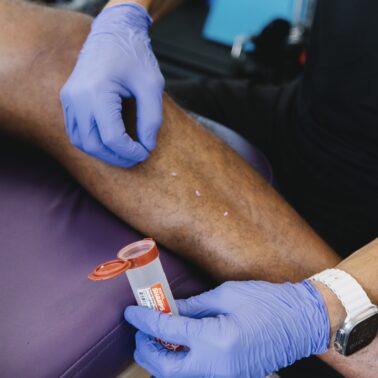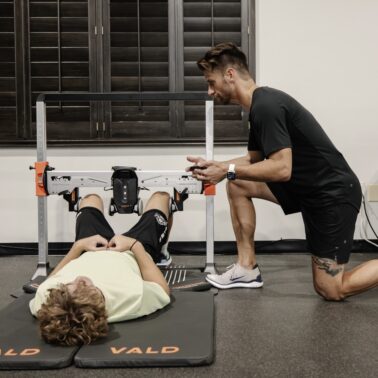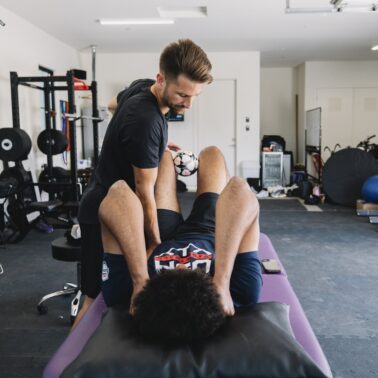“An integrated Return to Play strategy involves comprehensive assessments, interdisciplinary collaboration, and continuous progress monitoring for personalized athlete recovery.”
Adam Loiacono
What You Will Learn
- The significance of the biology-based approach that respects the unique healing timelines of different tissues to minimize re-injury risks.
- The need for personalized, athlete-specific rehabilitation programs that account for both functional performance and biological healing.
- Future directions in RTP, including the refinement of models, technological advancements, and the importance of long-term outcome studies.
The journey back to sports after an injury is a critical phase for athletes. This process, known as return to play (RTP) – also known as return to sport (RTS) – can be approached in various ways, notably through criteria-based or biology-based methodologies. Understanding the nuances of each approach, especially against the backdrop of tissue healing timelines, is paramount for ensuring a safe and effective return to athletic performance.
Understanding RETURN TO PLAY Approaches
Criteria-based approach
The criteria-based approach to return to play (RTP) is a systematic method that relies on specific, measurable milestones an athlete must achieve before resuming sports activities. This approach is grounded in the belief that if an athlete meets certain functional criteria, they are ready to return to their sport. These criteria often include:
- Strength: Athletes are typically required to reach a certain level of strength, often quantified as a percentage of the strength of the uninjured limb or pre-injury levels.
- Range of Motion: Restoring the injured limb’s range of motion to levels close to the uninjured limb or to the athlete’s baseline is a common criterion.
- Functional Performance: This includes specific performance tests relevant to the athlete’s sport, such as jumping, running, or agility drills, designed to mimic the demands of their sport.
This approach is favored for its objectivity and clarity. By setting clear, measurable targets, it provides athletes, coaches, and healthcare providers with tangible goals. Additionally, it can be tailored to the specific demands of different sports, ensuring that athletes are physically prepared for the unique challenges they will face upon their return.
However, there are limitations. The criteria-based approach may not adequately consider the biological healing process of the injured tissue. For example, an athlete might meet all functional criteria but still be within a critical period of tissue healing, making them vulnerable to re-injury. This method also tends to focus more on the physical aspects of recovery, potentially overlooking psychological readiness and other holistic aspects of health.
Biology-Based Approach
In contrast, the biology-based approach centers on the physiological and biological healing processes of the injured tissue. This approach operates on the understanding that each type of tissue (muscle, bone, ligament, etc.) has its own intrinsic healing timeline, which must be respected to minimize the risk of re-injury. Key aspects include:
- Healing Timelines: Recognizing that different tissues heal at different rates, this approach tailors the RTS timeline based on the specific nature of the injury.
- Biological Markers: In some cases, biological markers (such as imaging findings or biochemical markers) can be used to gauge the progress of tissue healing.
- Athlete-Specific Factors: Factors such as age, general health, and the presence of confounding factors can influence healing and are considered in this approach.
The biology-based approach is advantageous in that it respects the body’s natural healing process, potentially leading to a more sustainable and safer return to sport. By not rushing the athlete back before the tissue has adequately healed, it can reduce the risk of chronic problems or re-injury.
However, this approach has its own drawbacks. It can be less specific in terms of functional readiness for sport. An athlete’s tissue might have healed, but they may not yet have regained the necessary strength, coordination, or sport-specific skills. Additionally, biological healing timelines can be variable and influenced by many factors, making it challenging to predict exact RTS dates.
Tissue Healing Timelines and Their Relevance in RETURN TO SPORTS
Bone Healing: Bone injuries, depending on severity and location, typically heal within 6 to 12 weeks. The process involves inflammation, bone production, and remodeling. Nutrition, age, and the nature of the fracture can influence healing time.
- Dimitriou R, Jones E, McGonagle D, Giannoudis PV. Bone regeneration: Current concepts and future directions. BMC Med. 2011;9:66. doi:10.1186/1741-7015-9-66.
- Einhorn TA, Gerstenfeld LC. Fracture healing: Mechanisms and interventions. Nat Rev Rheumatol. 2015;11(1):45-54. doi:10.1038/nrrheum.2014.164.
Ligament Healing (Including ACL): Ligaments, particularly the ACL, have a prolonged healing timeline due to limited blood supply. The ACL recovery can extend up to a year, depending on surgery and rehabilitation strategies.
- Frank CB, Hart DA, Shrive NG. Molecular biology and biomechanics of normal and healing ligaments – a review. Osteoarthritis Cartilage. 1999;7(1):130-140. doi:10.1053/joca.1998.0153.
- Zhang J, Wang JH. The effects of mechanical loading on tendons – an in vivo and in vitro model study. PLoS One. 2013;8(8):e71740. doi:10.1371/journal.pone.0071740.
Muscle Healing: Muscle injuries heal in three phases: inflammatory response, repair, and remodeling. This process can take a few weeks to several months, influenced by the extent of injury and rehabilitation practices.
- Jarvinen TA, Jarvinen TL, Kaariainen M, Kalimo H, Jarvinen M. Muscle injuries: Biology and treatment. Am J Sports Med. 2005;33(5):745-764. doi:10.1177/0363546505274714.
- Menetrey J, Kasemkijwattana C, Day CS, Bosch P, Vogt M, Fu FH, Moreland MS, Huard J. Growth factors improve muscle healing in vivo. J Bone Joint Surg Br. 2000;82(1):131-137. doi:10.1302/0301-620X.82B1.0820131.
Achilles Tendon: Achilles tendon injuries are challenging due to the tendon’s poor blood supply. Healing can take up to a year, with a gradual return to full activity.
- Maffulli N, Ewen SW, Waterston SW, Reaper J, Barrass V. Tenocytes from ruptured and tendinopathic achilles tendons produce greater quantities of type III collagen than tenocytes from normal Achilles tendons. Am J Sports Med. 2000;28(4):499-505. doi:10.1177/03635465000280040801.
- Aspenberg P, Virchenko O. Platelet concentrate injection improves Achilles tendon repair in rats. Acta Orthop Scand. 2004;75(1):93-99. doi:10.1080/00016470410001708190.
Meniscus Healing: Meniscus injuries vary in healing potential, with tears in the vascularized outer region healing better than those in the avascular zone. Recovery might range from 6 weeks to several months.
- Beaufils P, Becker R, Kopf S, et al. The knee meniscus: Management of traumatic tears and degenerative lesions. EFORT Open Rev. 2017;2(5):195-203. doi:10.1302/2058-5241.2.160056.
- Kise NJ, Risberg MA, Stensrud S, Ranstam J, Engebretsen L, Roos EM. Exercise therapy versus arthroscopic partial meniscectomy for degenerative meniscal tear in middle aged patients: Randomised controlled trial with two year follow-up. BMJ. 2016;354:i3740. doi:10.1136/bmj.i3740.
Integrating Criteria and Biology in RETURN TO SPORTS
Integrating criteria-based and biology-based approaches in the return to sport (RTS) process represents a more comprehensive strategy, ensuring that decisions are informed by both functional performance measures and an understanding of the biological healing process. This integrated approach can provide a safer and more effective pathway for athletes returning from injury. Let’s delve deeper into this integration:
Advantages of an Integrated Approach
- Balanced Decision-Making: Combining both approaches allows for a more balanced decision-making process. Functional tests might indicate readiness, but biological markers can reveal if the tissue is still in a vulnerable healing phase. This dual perspective helps in making more informed decisions.
- Personalized Recovery Plans: Every athlete is unique, and their recovery from injury can vary significantly. An integrated approach allows for personalized recovery plans that consider the athlete’s specific functional achievements in conjunction with their unique biological healing process.
- Mitigating Re-Injury Risks: By acknowledging the biological healing timelines, this approach helps in mitigating the risks of re-injury. Even if an athlete feels ready to return and meets certain functional benchmarks, understanding the biological aspect ensures that they do not return too early and risk further injury.
Implementing the Integrated Approach
- Comprehensive Assessment: Implementing this approach requires comprehensive assessment protocols that include functional tests (like strength, flexibility, and sport-specific drills) and biological assessments (like imaging, biomarkers, and clinical examination).
- Interdisciplinary Collaboration: It involves collaboration between various healthcare professionals, including orthopedic surgeons, physical therapists, athletic trainers, and sports medicine physicians, to ensure a holistic evaluation of the athlete’s readiness.
- Monitoring Progress: Continuous monitoring and reassessment are vital. This might involve regular functional testing and medical imaging, along with close monitoring of any pain or discomfort reported by the athlete.
- Educating Athletes: Educating athletes about the importance of both functional and biological healing is crucial. Athletes should understand why they might need to wait longer before returning to sport, even if they feel physically ready.
POTENTIAL CHALLENGES
- Complexity of Integration: Integrating these two approaches can be complex, as it requires coordinated efforts and resources, which might not be readily available in all clinical settings.
- Varying Healing Timelines: Biological healing timelines can vary significantly among individuals, making it challenging to establish a one-size-fits-all protocol.
- Subjectivity in Assessment: While efforts are made to objectify the process, some elements of both criteria-based and biology-based assessments can be subjective.
The integration of criteria-based and biology-based approaches in RTS provides a more robust framework for safely returning athletes to sport. This approach respects both the functional readiness and the biological healing process, aiming to ensure the athlete’s long-term health and performance. However, its implementation requires careful coordination and a deep understanding of both functional and biological aspects of healing. This approach represents a significant advancement in sports medicine, offering a more nuanced and effective strategy for managing athlete injuries.
Practical Implications and Future Directions
The integration of criteria-based and biology-based approaches in return to sport (RTS) is a significant advancement in sports medicine and rehabilitation, with profound practical implications and directions for future research:
Practical Implications
- Personalized Rehabilitation Programs: This integrated approach necessitates the creation of personalized, athlete-specific rehabilitation programs. These programs would need to be flexible and adaptive, capable of evolving based on the athlete’s progress in both functional performance and biological healing.
- Enhanced Patient Education: Educating athletes about the importance of both aspects of recovery is crucial. Understanding the rationale behind each phase of their rehabilitation can improve adherence to the program and reduce frustration during the recovery process. Hopefully the implosion of AI and machine learning will influence this.
- Interdisciplinary Collaboration: Leaving the ego at the door and avoiding silos is critical. Effective implementation requires a multidisciplinary team, including physical therapists, sports medicine physicians, orthopedic surgeons, athletic trainers, and potentially other specialists. This collaboration ensures a comprehensive approach to the athlete’s recovery.
- Advanced Diagnostic Tools: The integration calls for the use of advanced diagnostic tools to assess tissue healing, such as imaging techniques and biomarkers. These tools can provide objective data to inform rehabilitation strategies and RTS decisions. Hopefully the advancement of augmented reality and virtual reality will enhance the diagnosis process.
Future Directions
- Refinement of Models: Future research should focus on refining these integrated models to provide more precise and injury-specific guidelines. This might involve developing new protocols that more accurately predict the optimal timing for RTS based on both functional and biological criteria.
- Technological Advancements: The development of new technologies, such as wearable devices and advanced imaging techniques, could offer more detailed insights into the recovery process, enabling more precise monitoring of both functional performance and tissue healing.
- Long-Term Outcomes Research: Long-term studies are needed to assess the effectiveness of the integrated approach in preventing re-injury and maintaining athletic performance. Understanding the long-term outcomes will help in optimizing RTS protocols.
- Personalized Medicine: With advancements in personalized medicine, including genomics and biologics, there’s potential for even more individualized recovery plans. Research could explore how individual differences in healing and response to therapy can be accounted for in rehabilitation programs.
- Psychological Aspects: Integrating psychological support and mental health strategies into the RTS process is another area for development. The psychological readiness of the athlete is a critical component of the overall RTP strategy.
- Collaborative Research: Encouraging collaborative research between institutions, sports teams, and medical facilities can lead to a broader understanding of the best practices in RTS and facilitate the development of universally accepted guidelines.
By addressing these practical implications and exploring these future directions, the field of sports medicine can continue to evolve, offering more effective, safer, and more personalized approaches to athlete rehabilitation and RTS. This integrated approach not only benefits the individual athlete but also contributes to the broader goal of enhancing sports health and performance standards.
Conclusion
The journey to RTS (or RTP) is a delicate balance between meeting functional criteria and respecting biological healing. An integrated approach that considers both aspects can optimize outcomes for injured athletes, paving the way for a safer and more effective return to sport.



